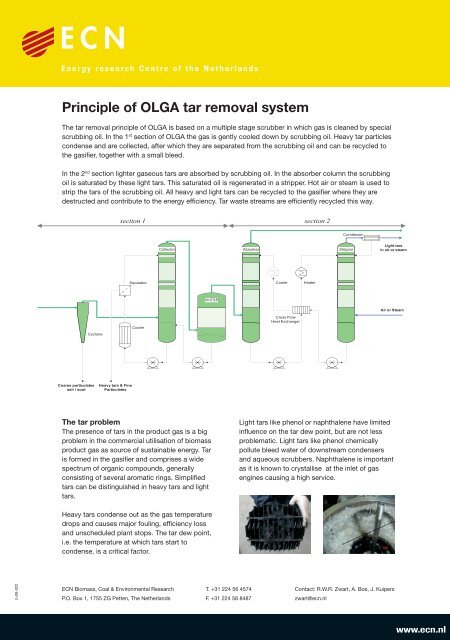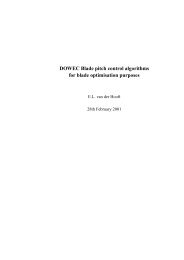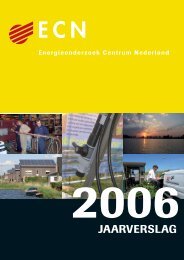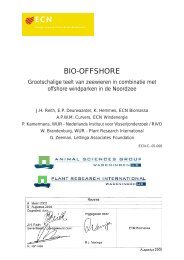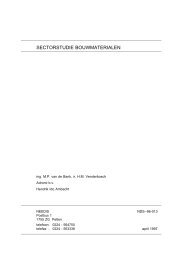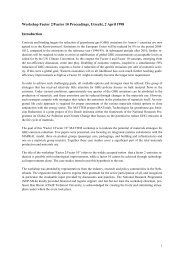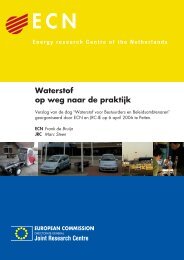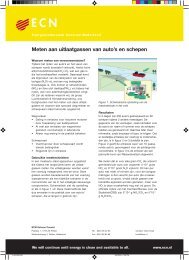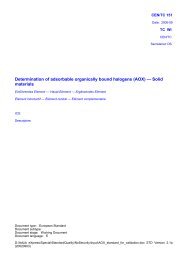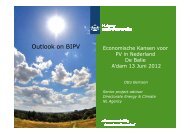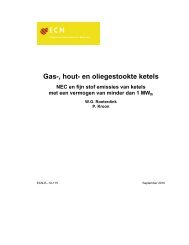Principle of OLGA tar removal system - ECN
Principle of OLGA tar removal system - ECN
Principle of OLGA tar removal system - ECN
You also want an ePaper? Increase the reach of your titles
YUMPU automatically turns print PDFs into web optimized ePapers that Google loves.
-08-022<br />
<strong>Principle</strong> <strong>of</strong> <strong>OLGA</strong> <strong>tar</strong> <strong>removal</strong> <strong>system</strong><br />
The <strong>tar</strong> <strong>removal</strong> principle <strong>of</strong> <strong>OLGA</strong> is based on a multiple stage scrubber in which gas is cleaned by special<br />
scrubbing oil. In the 1 st section <strong>of</strong> <strong>OLGA</strong> the gas is gently cooled down by scrubbing oil. Heavy <strong>tar</strong> particles<br />
condense and are collected, after which they are separated from the scrubbing oil and can be recycled to<br />
the gasifi er, together with a small bleed.<br />
In the 2 nd section lighter gaseous <strong>tar</strong>s are absorbed by scrubbing oil. In the absorber column the scrubbing<br />
oil is saturated by these light <strong>tar</strong>s. This saturated oil is regenerated in a stripper. Hot air or steam is used to<br />
strip the <strong>tar</strong>s <strong>of</strong> the scrubbing oil. All heavy and light <strong>tar</strong>s can be recycled to the gasifi er where they are<br />
destructed and contribute to the energy effi ciency. Tar waste streams are effi ciently recycled this way.<br />
Coarse particulates<br />
ash / soot<br />
Cyclone<br />
Heavy <strong>tar</strong>s & Fine<br />
Particulates<br />
<strong>ECN</strong> Biomass, Coal & Environmental Research<br />
P.O. Box 1, 1755 ZG Petten, The Netherlands<br />
section 1 section 2<br />
Separator<br />
Cooler<br />
Collector<br />
W-ESP<br />
The <strong>tar</strong> problem<br />
The presence <strong>of</strong> <strong>tar</strong>s in the product gas is a big<br />
problem in the commercial utilisation <strong>of</strong> biomass<br />
product gas as source <strong>of</strong> sustainable energy. Tar<br />
is formed in the gasifi er and comprises a wide<br />
spectrum <strong>of</strong> organic compounds, generally<br />
consisting <strong>of</strong> several aromatic rings. Simplifi ed<br />
<strong>tar</strong>s can be distinguished in heavy <strong>tar</strong>s and light<br />
<strong>tar</strong>s.<br />
Heavy <strong>tar</strong>s condense out as the gas temperature<br />
drops and causes major fouling, effi ciency loss<br />
and unscheduled plant stops. The <strong>tar</strong> dew point,<br />
i.e. the temperature at which <strong>tar</strong>s s<strong>tar</strong>t to<br />
condense, is a critical factor.<br />
Absorber<br />
T. +31 224 56 4574<br />
F. +31 224 56 8487<br />
Cooler<br />
Cross Flow<br />
Heat Exchanger<br />
Heater<br />
Condenser<br />
Stripper<br />
Light <strong>tar</strong>s<br />
in air or steam<br />
Air or Steam<br />
Light <strong>tar</strong>s like phenol or naphthalene have limited<br />
infl uence on the <strong>tar</strong> dew point, but are not less<br />
problematic. Light <strong>tar</strong>s like phenol chemically<br />
pollute bleed water <strong>of</strong> downstream condensers<br />
and aqueous scrubbers. Naphthalene is important<br />
as it is known to crystallise at the inlet <strong>of</strong> gas<br />
engines causing a high service.<br />
Contact: R.W.R. Zwart, A. Bos, J. Kuipers<br />
zwart@ecn.nl<br />
www.ecn.nl
Temperature ºC<br />
<strong>OLGA</strong> process philosophy<br />
Product gas contains solids, <strong>tar</strong>s and inorganic<br />
impurities. In principle mixing <strong>of</strong> dust, <strong>tar</strong> and<br />
water must be avoided. In any case it must be<br />
avoided to mix <strong>tar</strong> and water. The philosophy <strong>of</strong><br />
<strong>OLGA</strong> is based on dew point control. In the fi gure<br />
below the <strong>tar</strong> (TDP) and water dew points (WDP)<br />
are shown.<br />
Within the <strong>OLGA</strong>, <strong>tar</strong>s are fi rst condensed in a<br />
controlled way without condensing water. In the<br />
second section <strong>tar</strong>s are absorbed, lowering the<br />
TDP but not the WDP. As a result the TDP<br />
decreases to below the WDP, allowing the<br />
application <strong>of</strong> commercially available water based<br />
cleaning <strong>system</strong>s for inorganic components.<br />
The process consists <strong>of</strong> the following equipment<br />
(with typical temperatures between brackets):<br />
•<br />
•<br />
•<br />
•<br />
•<br />
•<br />
•<br />
•<br />
Gas cooler (from 700-900ºC to ~380 ºC)<br />
Separation <strong>of</strong> solids (~380ºC)<br />
Removal <strong>of</strong> coarse solids by a cyclone and<br />
<strong>OLGA</strong> for fi ne solid aerosols<br />
Removal <strong>of</strong> all solids by a hot gas fi lter<br />
<strong>OLGA</strong> <strong>tar</strong> <strong>removal</strong> (inlet ~380ºC, outlet ~80ºC)<br />
Safe above water dew point<br />
Water condenser (~80ºC to ~30 ºC)<br />
Water scrubber (~30 ºC)<br />
Advantages <strong>of</strong> <strong>OLGA</strong><br />
The <strong>OLGA</strong> <strong>system</strong> is a reliable and solid solution<br />
for the <strong>tar</strong> problem. The advantages can be<br />
summarized as follows:<br />
•<br />
•<br />
•<br />
•<br />
•<br />
•<br />
•<br />
•<br />
•<br />
Cooler<br />
Particle separation<br />
cyclone or<br />
Hot Gas Filter<br />
TDP ± 350 ˚C<br />
Water dew point ± 60 ˚C<br />
Condensation<br />
Absorption<br />
<strong>OLGA</strong><br />
Separation <strong>of</strong> :<br />
<strong>tar</strong>s & fine particles<br />
Dew points & process choices<br />
Water Quench,<br />
condenser & scrubber<br />
(inorganics )<br />
WDP ± 30 ºC<br />
Tar dew point < 10 ˚C<br />
No more <strong>tar</strong> related problems<br />
Increased <strong>system</strong> stability and availability<br />
Minimization <strong>of</strong> waste water treatment costs<br />
No <strong>tar</strong> waste streams<br />
Better gas quality compared to a thermal<br />
<strong>tar</strong> cracker<br />
More reliable and less vulnerable than a<br />
catalytic <strong>tar</strong> cracker<br />
No poisoned waste water; the problem <strong>of</strong> <strong>tar</strong><br />
<strong>removal</strong> by a water scrubber <strong>system</strong>s<br />
Experimental results<br />
In the fi gure below a typical experimental<br />
measured performance <strong>of</strong> <strong>OLGA</strong> is shown.<br />
Experimental results<br />
In the fi gure below a typical experimental<br />
measured performance <strong>of</strong> <strong>OLGA</strong> is shown. The<br />
performance is compared with conventional gas<br />
cleaning based on wet scrubbing and on a wet<br />
cleaning with an electrostatic precipitator (ESP).<br />
<strong>tar</strong> <strong>removal</strong><br />
The most important result is that the <strong>tar</strong> dew-point<br />
<strong>of</strong> the gas can be decreased to well below 20°C.<br />
This means that the gas is applicable without risk<br />
<strong>of</strong> <strong>tar</strong> condensation and fouling<br />
Commercial information<br />
The <strong>OLGA</strong> <strong>tar</strong> <strong>removal</strong> technology is a patented<br />
<strong>ECN</strong> invention. It was developed by a successful<br />
co-operation between <strong>ECN</strong> & Dahlman, which<br />
s<strong>tar</strong>ted in 2001 with lab scale tests.<br />
The activities <strong>of</strong> Dahlman and <strong>ECN</strong> are<br />
complemen<strong>tar</strong>y to each other. <strong>ECN</strong> has the lab<br />
and pilot scale facilities, Dahlman has engineering,<br />
project management and production facilities.<br />
<strong>ECN</strong> and Dahlman can <strong>of</strong>fer the following support<br />
to a gasifi cation project:<br />
•<br />
•<br />
•<br />
•<br />
•<br />
•<br />
•<br />
•<br />
•<br />
100%<br />
80%<br />
60%<br />
40%<br />
Wet scrubbing Idem + ESP <strong>OLGA</strong><br />
Heavy <strong>tar</strong>s 49% 99% 100%<br />
Light <strong>tar</strong>s 62% 74% 100%<br />
Heterocyclic 79% 79% 99%<br />
Dew point ( 0C) 180 60 < 20<br />
Chemical research<br />
Lab scale tests<br />
Pilot scale tests<br />
Process engineering packages<br />
Basic design and mechanical engineering<br />
Detailed engineering<br />
Turn key delivery & full project management<br />
Commissioning & s<strong>tar</strong>t-up on site<br />
Service & after sales<br />
Further information<br />
www.ecn.nl www.dahlman.nl<br />
<strong>OLGA</strong> <strong>tar</strong> <strong>removal</strong> technology website<br />
www.olgatechnology.com<br />
www.ecn.nl


